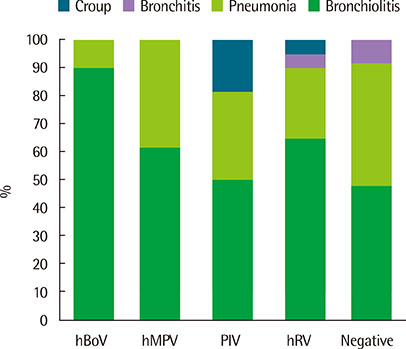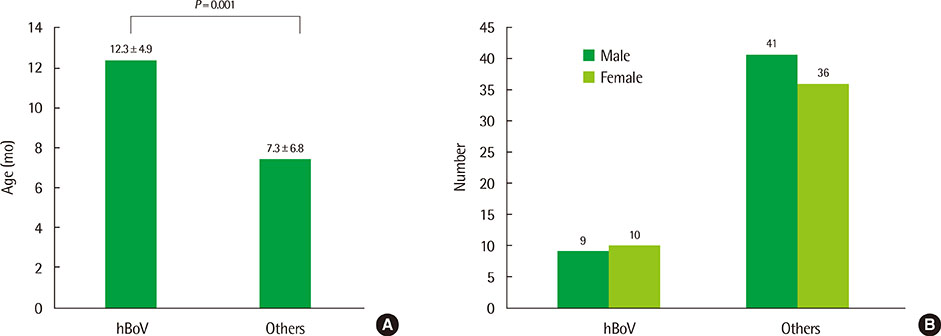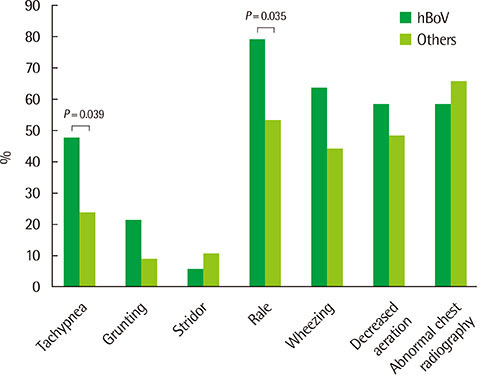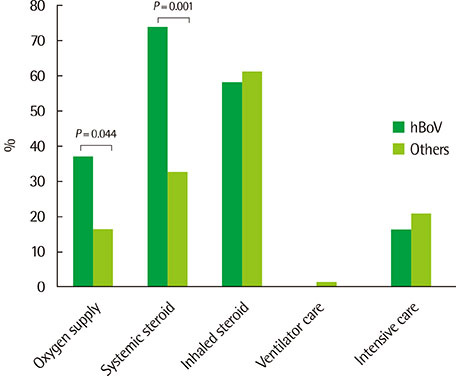Allergy Asthma Respir Dis.
2015 Nov;3(6):410-416. 10.4168/aard.2015.3.6.410.
Clinical characteristics of respiratory viral infection in children during spring/summer: focus on human bocavirus
- Affiliations
-
- 1Department of Pediatrics, Keimyung University School of Medicine, Daegu, Korea. joung756@dsmc.or.kr
- 2Department of Pediatrics, Kyungpook National University School of Medicine, Daegu, Korea.
- KMID: 2218629
- DOI: http://doi.org/10.4168/aard.2015.3.6.410
Abstract
- PURPOSE
We evaluated the clinical characteristics of respiratory viruses that were frequently found in children during spring/summer, namely, human bocavirus (hBoV), human metapneumovirus (hMPV), parainfluenza virus (PIV), and human rhinovirus (hRV).
METHODS
This study enrolled patients with acute lower respiratory infection in whom respiratory virus reverse transcriptase polymerase chain reaction was performed between March 2013 and August of 2013. We retrospectively reviewed the medical records to collect the patients' data.
RESULTS
A total of 96 patients were enrolled and divided into 5 categories: hBoV in 19 patients (19.8%), hMPV in 18 patients (18.8%), PIV in 16 patients (16.7%), hRV in 20 patients (20.8%), and negative result in 23 patients (24.0%). The mean age of the patients was 8.2+/-5.9 months (median, 7.5 months; range, 1-24 months), and the male-to-female ratio was 1.1:1. The most common diagnoses were acute bronchiolitis (62.5%) and pneumonia (30.2%). Compared to other patients, those with hBoV were older (12.3+/-4.9 months, P=0.001) and more frequently diagnosed with acute bronchiolitis (P=0.005). In addition, they showed higher incidences of tachypnea and rales (P=0.039 and P=0.035, respectively), and were more frequently treated with oxygen and systemic steroids (P=0.044 and P=0.001, respectively) than the other patients.
CONCLUSION
We compared respiratory viruses in children during spring/summer and found that hBoV may have more severe clinical manifestations than other viruses.
Keyword
MeSH Terms
Figure
Cited by 1 articles
-
Distribution and Characterization of Airborne Respiratory Pathogens in Public Facilities
Su-Jeong Hwang, Ho-Cheol Yun, Pyeong-Tae Ku, Ju-Hee Sim, Young-Wook Cha, Mi-Ok Lee
J Bacteriol Virol. 2018;48(4):121-129. doi: 10.4167/jbv.2018.48.4.121.
Reference
-
1. Kim KH, Lee JH, Sun DS, Kim YB, Choi YJ, Park JS, et al. Detection and clinical manifestations of twelve respiratory viruses in hospitalized children with acute lower respiratory tract infections : focus on human metapneumovirus, human rhinovirus and human coronavirus. Korean J Pediatr. 2008; 51:834–841.
Article2. Lim JS, Woo SI, Kwon HI, Baek YH, Choi YK, Hahn YS. Clinical characteristics of acute lower respiratory tract infections due to 13 respiratory viruses detected by multiplex PCR in children. Korean J Pediatr. 2010; 53:373–379.
Article3. Choi EH, Lee HJ, Kim SJ, Eun BW, Kim NH, Lee JA, et al. The association of newly identified respiratory viruses with lower respiratory tract infections in Korean children, 2000-2005. Clin Infect Dis. 2006; 43:585–592.
Article4. Yun BY, Kim MR, Park JY, Choi EH, Lee HJ, Yun CK. Viral etiology and epidemiology of acute lower respiratory tract infections in Korean children. Pediatr Infect Dis J. 1995; 14:1054–1059.
Article5. Papadopoulos NG, Moustaki M, Tsolia M, Bossios A, Astra E, Prezerakou A, et al. Association of rhinovirus infection with increased disease severity in acute bronchiolitis. Am J Respir Crit Care Med. 2002; 165:1285–1289.
Article6. Jartti T, Jartti L, Ruuskanen O, Soderlund-Venermo M. New respiratory viral infections. Curr Opin Pulm Med. 2012; 18:271–278.
Article7. Allander T, Tammi MT, Eriksson M, Bjerkner A, Tiveljung-Lindell A, Andersson B. Cloning of a human parvovirus by molecular screening of respiratory tract samples. Proc Natl Acad Sci U S A. 2005; 102:12891–12896.
Article8. Jartti T, Hedman K, Jartti L, Ruuskanen O, Allander T, Soderlund-Venermo M. Human bocavirus-the first 5 years. Rev Med Virol. 2012; 22:46–64.9. Ahn JG, Choi SY, Kim DS, Kim KH. Human bocavirus isolated from children with acute respiratory tract infections in Korea, 2010-2011. J Med Virol. 2014; 86:2011–2018.
Article10. Deng Y, Gu X, Zhao X, Luo J, Luo Z, Wang L, et al. High viral load of human bocavirus correlates with duration of wheezing in children with severe lower respiratory tract infection. PLoS One. 2012; 7:e34353.
Article11. Regamey N, Kaiser L, Roiha HL, Deffernez C, Kuehni CE, Latzin P, et al. Viral etiology of acute respiratory infections with cough in infancy: a community-based birth cohort study. Pediatr Infect Dis J. 2008; 27:100–105.12. Harris M, Clark J, Coote N, Fletcher P, Harnden A, McKean M, et al. British Thoracic Society guidelines for the management of community acquired pneumonia in children: update 2011. Thorax. 2011; 66:Suppl 2. ii1–ii23.
Article13. Fernandes RM, Bialy LM, Vandermeer B, Tjosvold L, Plint AC, Patel H, et al. Glucocorticoids for acute viral bronchiolitis in infants and young children. Cochrane Database Syst Rev. 2013; 6:CD004878.
Article14. Vallet C, Pons-Catalano C, Mandelcwajg A, Wang A, Raymond J, Lebon P, et al. Human bocavirus: a cause of severe asthma exacerbation in children. J Pediatr. 2009; 155:286–288.
Article15. Korner RW, Soderlund-Venermo M, van Koningsbruggen-Rietschel S, Kaiser R, Malecki M, Schildgen O. Severe human bocavirus infection, Germany. Emerg Infect Dis. 2011; 17:2303–2305.
Article16. Jartti T, Jartti L, Peltola V, Waris M, Ruuskanen O. Identification of respiratory viruses in asymptomatic subjects: asymptomatic respiratory viral infections. Pediatr Infect Dis J. 2008; 27:1103–1107.17. Allander T, Jartti T, Gupta S, Niesters HG, Lehtinen P, Osterback R, et al. Human bocavirus and acute wheezing in children. Clin Infect Dis. 2007; 44:904–910.
Article18. McIntosh K. Human bocavirus: developing evidence for pathogenicity. J Infect Dis. 2006; 194:1197–1199.
Article19. Kahn J. Human bocavirus: clinical significance and implications. Curr Opin Pediatr. 2008; 20:62–66.
Article20. Chung JY, Han TH, Kim CK, Kim SW. Bocavirus infection in hospitalized children, South Korea. Emerg Infect Dis. 2006; 12:1254–1256.
Article21. Kim JS, Lim CS, Kim YK, Lee KN, Lee CK. Human bocavirus in patients with respiratory tract infection. Korean J Lab Med. 2011; 31:179–184.
Article22. Choi JH, Paik JY, Choi EH, Lee HJ. Epidemiologic characteristics of human bocavirus-associated respiratory infection in children. Korean J Pediatr Infect Dis. 2011; 18:61–67.
Article23. Mansbach JM, Piedra PA, Teach SJ, Sullivan AF, Forgey T, Clark S, et al. Prospective multicenter study of viral etiology and hospital length of stay in children with severe bronchiolitis. Arch Pediatr Adolesc Med. 2012; 166:700–706.
Article24. Hustedt JW, Vazquez M. The changing face of pediatric respiratory tract infections: how human metapneumovirus and human bocavirus fit into the overall etiology of respiratory tract infections in young children. Yale J Biol Med. 2010; 83:193–200.25. Garcia-Garcia ML, Calvo C, Falcon A, Pozo F, Perez-Brena P, De Cea JM, et al. Role of emerging respiratory viruses in children with severe acute wheezing. Pediatr Pulmonol. 2010; 45:585–591.
Article26. Ma X, Endo R, Ishiguro N, Ebihara T, Ishiko H, Ariga T, et al. Detection of human bocavirus in Japanese children with lower respiratory tract infections. J Clin Microbiol. 2006; 44:1132–1134.
Article27. Calvo C, Garcia-Garcia ML, Pozo F, Carvajal O, Perez-Brena P, Casas I. Clinical characteristics of human bocavirus infections compared with other respiratory viruses in Spanish children. Pediatr Infect Dis J. 2008; 27:677–680.
Article28. Shin HW, Cho HL, You JH, You EJ, Kim EY, Kim KS, et al. Comparison of Clinical Manifestations of RSV, Rhinovirus and Bocavirus Infections in Children with Acute Wheezing. Pediatr Allergy Respir Dis. 2011; 21:334–343.
Article
- Full Text Links
- Actions
-
Cited
- CITED
-
- Close
- Share
- Similar articles
-
- Epidemiologic Characteristics of Human Bocavirus-Associated Respiratory Infection in Children
- Human Bocavirus in Patients with Respiratory Tract Infection
- Seasonality of asthma exacerbation in children caused by respiratory virus infection and allergen sensitization
- Acute viral lower respiratory tract infections in children
- Evaluation of the Temporal Association between Kawasaki Disease and Viral Infections in South Korea





